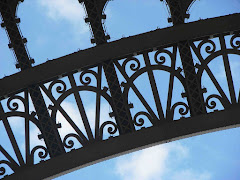.jpg) We didn’t cross every threshold of every museum; we could have visited many more. We had no specific museums on our itinerary for London, but there were two for Paris: the Musée du Louvre and the Musée d'Orsay
We didn’t cross every threshold of every museum; we could have visited many more. We had no specific museums on our itinerary for London, but there were two for Paris: the Musée du Louvre and the Musée d'OrsayThe list of masterpiece/famous/recognizable works in the Louvre is as long as the museum’s miles of corridors. Certainly the Mona Lisa is top of the list and we shared that experience as soon as we entered the museum. We then moved on, through the Italian Renaissance and French Romanticism and ended up in the Egyptian Antiquities, not because of any particular passion for that collection, but simply from wandering. Once in the long hall of glass cases and rooms with ceilings high enough to accommodate the 3200 year old giant statue of the seated Ramesses II, we drifted from item to item, occasionally reading the descriptions, but mostly just looking and looking.
.jpg)
Like so many museums, the buildings which house the Musée du Louvre and the Musée d'Orsay are artworks in and of themselves. The Louvre’s Baroque richness comes from its 17th century role as the palace of kings; the d’Orsay’s grandiose yet functional space comes from its original use as a train station which opened in 1900. The Louvre was transformed into a museum a little over 300 years ago, the d’Orsay a little over 20. The 35,000+ items in the Louvre date from the dawn of civilization to the mid-nineteenth century which is where the d’Orsay’s collections begin and then end in 1914. The collections in both buildings tend to speak to the period of the buildings themselves.

We entered the d’Orsay after a 45 minute wait in a snaking Disney-esque line and went first to the sixth floor to ensure our time some favorites: Lauren with Monet, Hannah with Toulouse-Lautrec and I with Van Gogh. Unlike the Louvre, here the rooms were smaller, quieter, more dimly lit. There seemed to be more time to gaze and ponder and occasionally get lost in an image that seemed to reach out to me and not rely on me to reach into it. After the crush of the crowd at the Louvre to see the Mona Lisa, we were surprised at the group tours and the dazed individuals walking past Whistler’s Mother without a second glance. For us, Mother is as big a cultural icon, as much a masterpiece as Mona, so we paused and gazed uninterrupted.

.jpg)
.jpg)
.jpg)
.jpg)
.jpg)
.jpg)
.jpg)
.jpg)
.jpg)
.jpg)
.jpg)
.jpg)
.jpg)
.jpg)
.jpg)
.jpg)
.jpg)
.jpg)
.jpg)
.jpg)
.jpg)
.jpg)
.jpg)
.jpg)
.jpg)
.jpg)
.jpg)
.jpg)
.jpg)
.jpg)
.jpg)
.jpg)
.jpg)

.jpg)